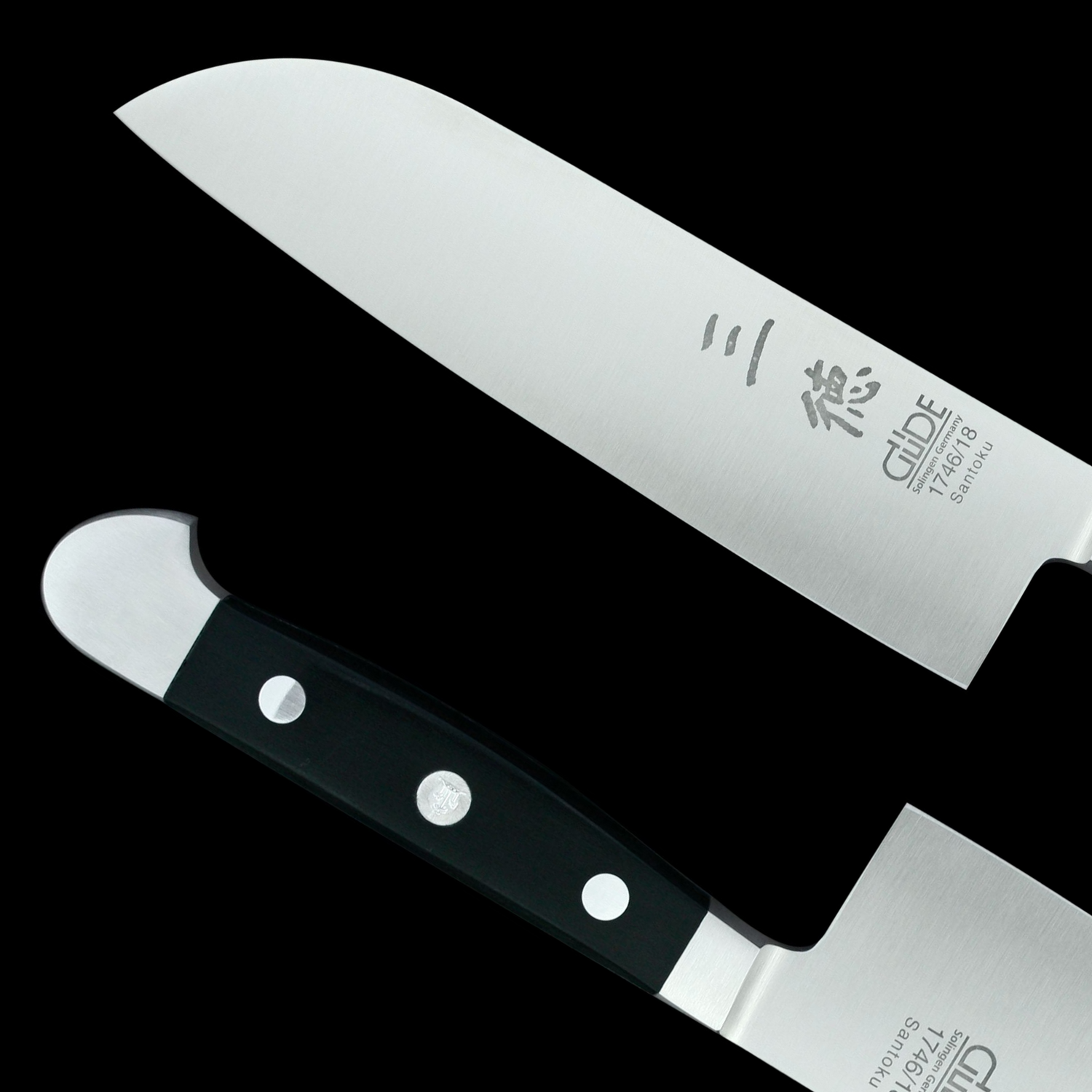
Bird's Beak Knife
Typical Applications - peel in the hand
Typical Cutting Material - Fruit, vegetables, potatoes
Special Features - The curved blade is particularly suitable for peeling

Boning Knife
Typical Applications - cut on the bone, parry tendons, (pulling cut on the board)
Typical Cutting Material - Meat, poultry
Special Features - The rigid blade is particularly suitable for extracting bones

Bread Knife
Typical Applications - Cutting on the board
Typical Cutting Material - Bread, pumpkin, melon, crusty roast, everything with a hard crust and soft core
Special Features - Thanks to the special Gude serrated edge and its length of up to 12 in, it is suitable for literally any type of bread and an always precise cut.

Carving Knife
Typical Applications - cutting on the board, pulling cut on the board, (weighing cut on the board)
Typical Cutting Material -Meat, sausage, ham, roasts
Special Features - The long blade ensures a precise cut, while the narrow blade reduces sticking of the food. The front part of the SYNCHROS carving knife is ground thin so that the blade is flexible in this area. This makes the SYNCHROS carving knife equally suitable for filleting fish.

Cheese Knife
Typical Applications - Cutting on the board
Typical Cutting Material - Cheese
Special Features - The recesses reduce the adhesion of the cheese to the blade.

Chef's Knife
Typical Applications - cutting on the board, pulling cut on the board, weighing cut on the board, chopping cut on the board
Typical Cutting Material - Fruit, vegetables, herbs, potatoes, sausage, cheese, meat, fish, poultry
Special Features - The chef's knife is the great all-rounder in the kitchen.

Chinese Chef's Knife
Typical Applications - cutting on the board, pulling cut on the board, (cradle cut on the board), chopping cut on the board
Typical Cutting Material - Fruit, vegetables, herbs, potatoes, sausage, cheese, meat, fish, poultry
Special Features - The wide blade creates a safe distance to the cutting board.

Fillet Knife
Typical Applications - fillet
Typical Cutting Material - Fish
Special Features - The flexible blade is particularly suitable for filleting fish.

Herb Knife Shark
Typical Applications - Cradle cut on the board
Typical Cutting Material - Herbs, garlic, ginger
Special Features - The crowned round fabric is perfect for the cradle cut on the board.

Paring Knife
Typical Applications - larding of e.g. roast venison with pieces of bacon, peeling/slicing in the hand, (pulling) slicing on the board
Typical Cutting Material - Fruit, vegetables, potatoes, sausage, cheese
Special Features - The paring knife is the little all-rounder in the kitchen.

Slicing Knife
Typical Applications - cutting on the board, pulling cut on the board, (weighing cut on the board)
Typical Cutting Material -Meat, sausage, ham, roasts
Special Features - The long blade ensures a precise cut, while the narrow blade reduces sticking of the food. The front part of the SYNCHROS carving knife is ground thin so that the blade is flexible in this area. This makes the SYNCHROS carving knife equally suitable for filleting fish.

Santoku Knife
Typical Applications - cutting on the board, pulling cut on the board, weighing cut on the board, chopping cut on the board
Typical Cutting Material - Fruit, vegetables, herbs, potatoes, sausage, cheese, meat, fish, poultry
Special Features - Santoku means "three uses", meaning fish, meat and vegetables. This makes the santoku knife the all-rounder in Japanese cuisine.

Steak Knife
Typical Applications - Cutting on the board, spreading spreads
Typical Cutting Material - Butter, spread, fruit, vegetables, sausage, cheese, meats
Special Features - The round tip is particularly suitable for spreading butter and spreads. The fine serration can be used to "score" a dish or crust.

Tomato Knife
Typical Applications - Cutting on the board
Typical Cutting Material - Everything with a hard shell and soft core, fruit, vegetables, potatoes, hard sausage
Special Features - The serrated edge is particularly suitable for "scoring" a hard shell or crust.

